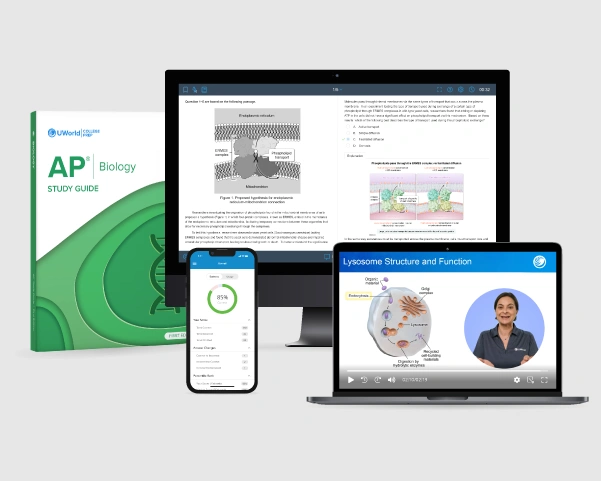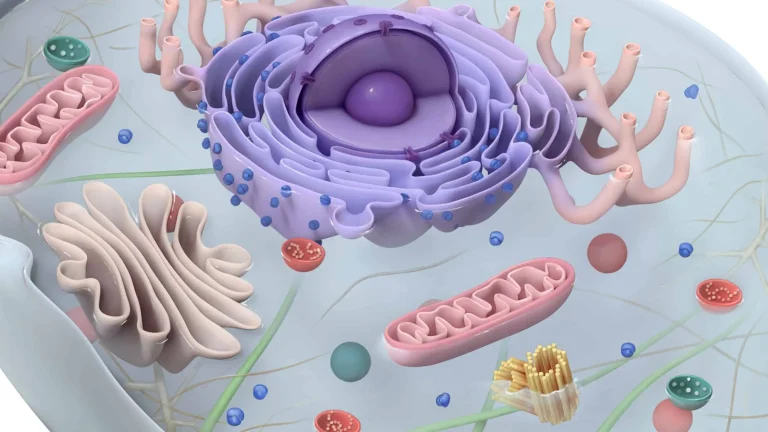In this article, we'll break down the AP Bio exam format to help you become familiar with the question styles you will see!
What Is the Format of the AP Biology Exam?
Let's start with the basics of the AP Biology exam structure. It's a reasonably lengthy one, lasting a total of 3 hours. The exam consists of two main sections: multiple-choice and free-response.
| Section | Duration | Questions | Scoring | Weightage |
|---|---|---|---|---|
| Section I: Multiple-Choice Questions (MCQs) | 1 hour and 30 minutes | 60 questions | 1 point for each question. No points are deducted for incorrect answers. | 50% of the total score |
| Section II: Free-Response Questions (FRQs) | 1 hour and 30 minutes | 6 questions | 2 long questions worth 8-10 points each and 4 short questions worth 4 points each. Scored based on specific criteria. | 50% of the total score |
In Section I of the AP Biology exam, you’ll find a mix of individual questions and question sets. Each set usually includes 4–5 questions based on a short passage that may feature graphs, tables, diagrams, or other visuals. Since this section lasts 90 minutes, try to spend about one minute on each question. This pacing will give you extra time to review your answers or revisit any skipped questions. Using an AP Biology exam review course can help you practice this timing and improve your test-taking strategy. Remember, there’s no penalty for wrong answers, so always make an educated guess even if you’re unsure.
“AP Biology isn’t just a test; it’s a chance to showcase your scientific reasoning and critical thinking skills. Remember, each question is an opportunity to prove what you’ve learned, so approach the exam with confidence and strategy!”
In Section II, you’ll tackle two types of questions:
- Long questions: These require detailed explanations, data analysis, and critical thinking, typically worth 8-10 points each.
- Short questions: These are more concise and generally worth 4 points each.
Your responses in Section II are evaluated based on specific scoring criteria, so clarity and precision are key.
Types of Questions on the AP Biology Exam
The MCQs and FRQs test your knowledge of the four big ideas in AP Biology and your proficiency in science practices. However, just understanding the content isn’t enough for a high score. Knowing the types of questions and how to tackle them is crucial. Below, we break down each question type and provide insights into their structure.
Multiple-Choice Questions (MCQ)
MCQs can be standalone or presented in sets of 4 or 5 questions based on a specific passage. These passages often include figures (graphs/tables/diagrams) and text. Each question provides 4 answer choices.
Understanding the weightage of each unit in the AP Biology exam structure can help you prioritize your preparation:
| Unit | Weightage in MCQ Section |
|---|---|
| Chemistry of Life | 8–11% |
| Cell Structure and Function | 10–13% |
| Cellular Energetics | 12–16% |
| Cell Communications and Cell Cycle | 10–15% |
| Heredity | 8–11% |
| Gene Expression and Regulation | 12–16% |
| Natural Selection | 13–20% |
| Ecology | 10–15% |
In addition to testing these units, MCQs evaluate 6 key science practices:
| Science Practice | Weighting |
|---|---|
| Concept Explanation | 25–33% |
| Visual Representations | 16–24% |
| Question & Method | 8–14% |
| Representing & Describing Data | 8–14% |
| Statistical Tests Data Analysis | 8–14% |
| Argumentation | 20–26% |
You can read our article on how to approach AP Biology multiple-choice questions to help you ace this section. It includes examples with step-by-step instructions on how to answer each question.
To prepare effectively, check out UWorld’s AP Biology Practice questions that closely mirror the actual exam and include detailed explanations to help you master every concept.
Additionally, explore UWorld’s AP Biology Study Guide, available in both print and digital formats. This guide offers in-depth explanations for challenging topics, expert tips for tackling difficult questions, and visually engaging illustrations to simplify complex concepts. It's designed to help you build confidence and excel on exam day.

Free-Response Questions (FRQs)
FRQs require detailed paragraph-form responses. These are graded manually by AP instructors and college teachers called AP Readers, based on specific scoring criteria.
There are 2 types of free-response questions — long-answer and short-answer. The long-answer questions are worth 8 to 10 points each, while the short-answer questions are worth 4 points each.
Wondering how each of these questions will be structured on the AP Bio exam length? Let’s take a look!
These questions test your ability to analyze data, interpret graphs, and justify predictions with evidence.
Free-response question 1 - Interpreting and Evaluating Experimental Results
The goal of this question is to evaluate your ability to interpret the data presented related to a particular scientific investigation scenario.
| To do | Points | |
|---|---|---|
| Part A | Describe and explain processes, models, or concepts | 1 to 2 |
| Part B | Identity and justify the experimental procedures used | 3 to 4 |
| Part C | Data analysis | 1 to 3 |
| Part D | Make predictions based on the given data and provide justifications with evidence | 2 to 4 |
Free-response question 2 - Interpreting and Evaluating Experimental Results with Graphing.
The goal of this question is to evaluate your ability to interpret the data presented as a graph and/or table which is related to a particular scientific investigation scenario.
| To do | Points | |
|---|---|---|
| Part A | Describe and explain processes, models, or concepts | 1 to 2 |
| Part B | Use confidence intervals or error bars and construct a graph or chart | 4 |
| Part C | Data analysis | 1 to 3 |
| Part D | Make predictions and provide justifications with evidence | 1 to 3 |
Each of the four short-answer questions pertains to a different one of the four big ideas and tests your knowledge of content from one of the eight instructional units.
Free-response question 3 - Scientific Investigation
The focus of this question is a lab investigation requiring you to demonstrate understanding of four skills.
| To do | Points | |
|---|---|---|
| Part A | Describe processes or concepts | 1 |
| Part B | Identify the procedures used in the investigation | 1 |
| Part C | Make predictions of experimental results | 1 |
| Part D | Justify the predictions you made | 1 |
Free-response question 4 - Conceptual Analysis
This four-part question includes a description of a particular biological phenomenon that is subject to disruption.
| To do | Points | |
|---|---|---|
| Part A | Describe processes or concepts | 1 |
| Part B | Explain processes or concepts | 1 |
| Part C | Predict the cause or effect of a specific change in a particular biological system | 1 |
| Part D | Use evidence to justify the prediction made | 1 |
Free-response question 5 - Analyze Model or Visual Representation
This question concentrates on a biological scenario along with a visual representation or model to study.
| To do | Points | |
|---|---|---|
| Part A | Characterize the concepts, processes, or models that are visually represented in the question | 1 |
| Part B | Explain relationships between these characteristics | 1 |
| Part C | Represent these relationships in a biological model | 1 |
| Part D | Explain how the visually represented concept or process aligns with larger biological theories and principles | 1 |
Free-response question 6 - Analyze Data
Showcase your understanding of a set of data represented visually in a graph or table.
| To do | Points | |
|---|---|---|
| Part A | Data description | 1 |
| Part B | Data description | 1 |
| Part C | Evaluate a hypothesis or prediction using the data provided | 1 |
| Part D | Explain how the results of the experiment align with larger biological theories and principles | 1 |
Did you recognize how these questions highlight a particular science practice? Here's a table that shows each science practice and which questions align with them.
| Science Practice | Free-Response Question |
|---|---|
| Concept Explanation | Questions 1, 2, 3, 4 & 5 |
| Visual Representation | Question 5 |
| Questions and Methods | Questions 1 & 3 |
| Representing and Describing Data | Questions 1, 2 & 6 |
| Statistical Tests and Data Analysis | Questions 1, 2 & 6 |
| Argumentation | Questions 1, 2, 3, 4 & 6 |
You can read our article on how to approach free-response AP Biology questions to help you ace this section. To master the AP Biology exam, explore UWorld’s AP Biology Prep Course. This all-in-one online study solution offers comprehensive resources, including challenging practice questions, detailed explanations, and step-by-step guidance for every question type to help you succeed.
AP Biology Exam — Digital Format?
The AP Bio exam format now follows a hybrid digital structure. You'll complete MCQs and view FRQs using the Bluebook testing app. However, free-response answers must be handwritten in paper exam booklets.
Understanding the AP Bio exam length and format is the first step to doing well. So, now that you know what the exam format is and what to expect from each section, you can chalk out an efficient and effective study plan. Be mindful of the number of questions and the AP Biology exam time, ensuring you allocate enough time to review your answers.

References
- (2024). AP® Biology. Courses & Exam Pages. AP Central. Retrieved on December 26, 2024 from https://apstudents.collegeboard.org/courses/ap-biology/assessment
- (2024). AP® Biology Course and Exam Description. College Board. Retrieved on December 26, 2024 from https://apcentral.collegeboard.org/media/pdf/ap-biology-course-and-exam-description.pdf
Read More About the AP Biology Exam
This article has everything you must know about the AP Biology exam scoring system— including score distribution, and the average score you will need to receive the college credit!
AP Biology CEDCheck out our guide to the AP Biology curriculum for more in-depth information on the exam layout, science practices, and the units, topics, and key concepts you will study in the course.
AP Biology Study Plan & TipsWant to know about the ultimate tips and best resources needed to get the highest score possible in AP Biology? Click on UWorld expert’s step-by-step guide to scoring a 5 in AP Biology.
Best AP Biology Prep Course ReviewSearching for top AP Biology prep courses? Read this review to compare the best courses and choose the perfect one for your success.
Best AP Biology Study Guide ComparisonCompare the best AP Biology study guides! See how Kaplan, Barron's, and Princeton Review stack up against UWorld for comprehensive exam prep.
How to Self-Study for AP BiologyLearn effective tips and strategies to self-study for the AP Biology exam. Build confidence, master core concepts, and achieve a high score independently too.




